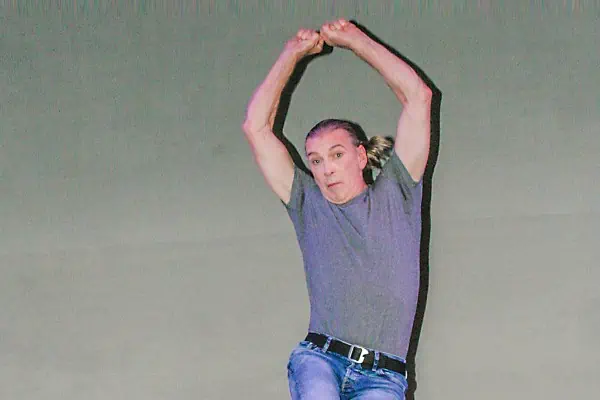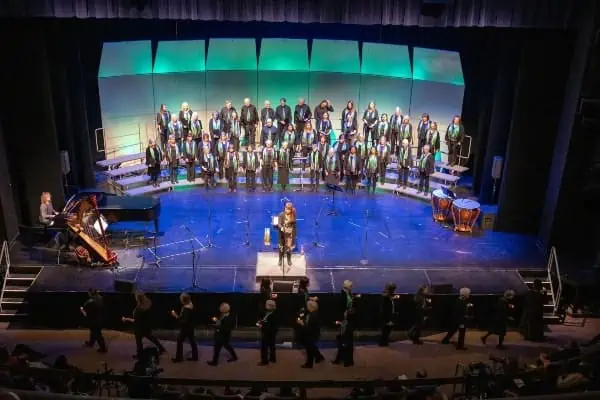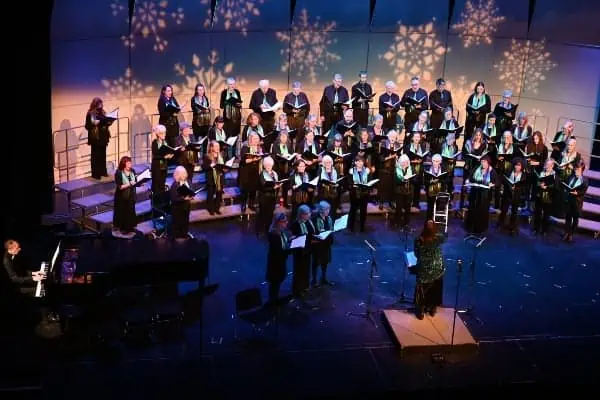It’s 7: 25 on a Monday evening. Over the past few minutes, 67 members of the Whitehorse Community Choir have arrived at the Whitehorse United Church and taken their places.
Microphone in hand, Barbara Chamberlin calls out, “OK, let’s stand up. Let’s have a massage.”
The atmosphere is lighthearted as the singers turn in their pews and give each other shoulder rubs.
What follows resembles a gym class: shoulder rolls, bending, trees-in-the- wind stretching exercises, hip rolls, knee bends, breathing drills, face massages, wide-mouthed yawns.
Regardless of age, size, or gender, nobody holds back. These people are having fun.
At exactly 7:30, Chamberlin says, “OK, we’re going to go right through it and fix little things. Does everyone have their pencils?”
A small “Shush” from the front and there is immediate silence.These 67 people – as well as Chamberlin and accompanist Barry Kitchen – are here for one purpose: to perfect the choir’s interpretation of Wolfgang Amadeus Mozart’s beautiful and complex Requiem Mass in D Minor.
This is Chamberlin’s sixth season directing the choir. The groundwork for taking on this challenging work has been under construction for awhile, she explains.
“We did ‘Lacrimosa’ my first term of conducting, and I just started exploring from there, because we’ve all heard ‘Lacrimosa’ and probably ‘Dies Irae,'” she says.
“Then you get into some of the other pieces, and they’re beautiful, well-crafted and amazing pieces. We started about two and a half years ago doing two a term, so we had actually done a good part of the Requiem before we started in January.”
The Requiem was Mozart’s last composition, begun as a commissioned piece just three months before his death at the age of 35.
Parts of the score (just how much is still disputed) were completed by other composers so that Mozart’s widow could collect the badly-needed final payment from the secretive Austrian Count who had commissioned it.
As a musical setting of the Roman Catholic liturgy for someone who is deceased (“requiem” means “rest”), the work is sung entirely in Latin.
“Latin is a really good language to sing in,” Chamberlin explains. “The vowels are very pure. When you get everybody on the same vowel at the same time, the focus becomes very similar and we get this great sound out of it.”
Carl Rumscheidt has sung bass in 10 to 12 concerts since joining the choir ten years ago. The language of the Requiem, he admits, can pose challenges.
“We’re singing in a language that none of us understands, and we’re not all singing the same words at the same time,” he says. “Unless you’re paying really close attention, you can lose it quickly.”
Still, he’s proud of the choir’s approach to the task.
“My sense is that people came out this time because they wanted to be part of something really interesting. And it’s felt positive, right the way through.”
Both Chamberlin and Rumscheidt acknowledge the role played by Brainerd Blyden-Taylor, founder of the renowned Nathaniel Dett Chorale, who worked with the choir earlier this month, focussing on such things as diction and tone production.
“Barb works on that a lot, and Blyden-Taylor was relentless on that,” Rumscheidt says. “To do this piece right, you’ve got to get that.”
Another member who appreciates Blyden-Taylor’s input is tenor Trevor Ratcliff, a newcomer to the choir whose last public singing was in a high school musical years ago.
“The experience was unbelievable. I learned so much about choir, and just my own individual voice. It was fabulous.”
Ratcliff regrets waiting so long before joining the choir, but relishes the experience.
“Just singing with a group was definitely a challenge, because I had not ever done that before. The piece itself is certainly a challenge; it has a lot of notes.”
As the choir – now up to 73 members – works its way through “Requiem aeternum” and “Kyrie eleison” the focus on both musical and lyric precision is obvious.
When Chamberlin gets the singers onto their feet for “Dies Irae”, the church’s laminated beams vibrate almost visibly from the explosion of sound.
But why do so many people, ranging from a teenaged bass to long-time members well past their teen years, volunteer every Monday evening – and more – to do something so demanding?
Rumscheidt sums it up this way:
“In every practice you end up doing a couple of things really well, and there’s that instant sense of, ‘Hey, we just did something good and something nice.’ I never, ever leave a practice not feeling better than when I went in.”
The choir’s Requiem will feature soloists Sonja Anderson (soprano), Anna Tamm-Relyea (alto), Roelof Oostwoud (tenor) and Gary Relyea (bass).
The 30-piece orchestra will include members of the Suzuki Senior Strings, as well as concertmaster Robert Richardson, Jr. and two colleagues from the Suzuki program at Manitoba’s Brandon University.
The Persephone Singers, the Neptunes and the Chamber Choir will also be part of the two performances, May 6 and 7 at the Yukon Arts Centre, starting at 8 pm.




